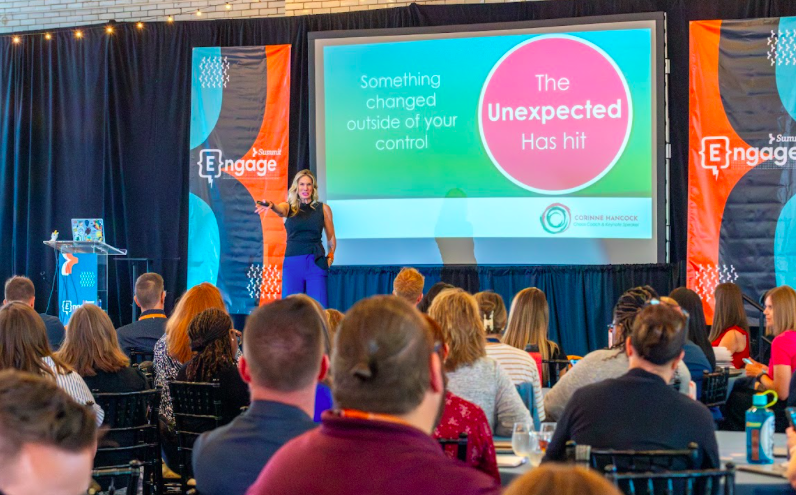The ACE Approach: Navigating Higher Ed’s Biggest Challenges
by Sirley Carballo · Updated Sep 13, 2024

It’s no surprise that institutions face numerous challenges that can create chaos and uncertainty. From shifts in enrollment patterns to changing student expectations and increasing staff turnover, navigating these obstacles requires a proactive and strategic approach.
The ACE response, introduced by Corinne Hancock, provides a powerful framework for individuals to embrace chaos and transform it into an advantage for personal and professional growth.
In this blog, we will explore how higher ed institutions can apply the ACE response to effectively deal with three upcoming challenges: the enrollment cliff, changing student expectations, and increased staff turnover.
What Is The Ace Approach To Navigating Chaos?
The ACE response is a framework for dealing with chaos and change in a productive way.
- A stands for Accept: Accept the reality of the chaos or change and acknowledge any emotions or resistance that may come with it.
- C stands for Choose: Choose a proactive mindset and decide how you want to respond to the situation, focusing on what you can control.
- E stands for Execute: Take action based on your chosen response and implement strategies to navigate the chaos effectively.
Corinne emphasizes that by following the ACE approach, individuals can harness the power of chaos and turn it into an advantage for personal and professional growth. Through accepting, choosing, and executing, individuals can build resilience, adaptability, and the ability to thrive in chaotic and uncertain environments.
A - Accepting the Reality
The first step in the ACE response is to accept the reality of the challenges ahead. For higher ed institutions, the looming enrollment cliff is a pressing concern. As demographic shifts lead to a decrease in the number of traditional college-age students, institutions must prepare for a potential decline in enrollment.
Accepting this reality involves acknowledging the impact it may have on revenue, resources, and long-term sustainability.
Additionally, institutions need to acknowledge the changing expectations of today's students. With access to instant communication and real-time information, students expect higher ed institutions to be responsive, transparent, and accessible. This shift in expectations poses a challenge for institutions that must adapt their communication strategies and support systems to meet students' needs effectively.
Lastly, the rising staff turnover rates present another challenge for higher ed institutions. Losing experienced staff members can disrupt institutional continuity, affect student support, and strain remaining team members. Accepting the reality of staff turnover requires institutions to address potential causes and develop retention strategies.

Meet Students Where They Are
With its powerful and customizable platform, Element451 can provide an unparalleled level of support to institutions seeking to engage with their students in a more effective and dynamic way.
See Element451 In Action
C - Choosing a Proactive Mindset
Once higher ed institutions have accepted the reality of these challenges, it is crucial to choose a proactive mindset and respond strategically.
To tackle the enrollment cliff, institutions can focus on diversifying their student recruitment strategies. This may include targeting new geographic areas, expanding online program offerings, or engaging in strategic partnerships to attract a broader student base. Moreover, institutions can invest in data-driven enrollment management to identify trends and opportunities for targeted outreach.
In response to changing student expectations, institutions must prioritize communication and responsiveness. This can be achieved by leveraging technology to improve communication channels, providing timely responses to student inquiries, and offering support services that cater to individual needs.
Choosing a proactive approach to student expectations fosters a sense of trust and loyalty, enhancing student satisfaction and retention.
Addressing increased staff turnover involves developing a supportive and inclusive work environment. Higher ed institutions can implement professional development programs, mentorship opportunities, and clear career paths to encourage staff growth and advancement. By choosing to invest in their employees, institutions can cultivate a culture of loyalty and dedication among the staff.
E - Executing with Resilience
The final stage of the ACE response is executing with resilience, taking action based on the chosen responses to the challenges.
For the enrollment cliff, institutions must continuously monitor enrollment data, adjust recruitment strategies as needed, and adapt to changing market demands. Flexibility and resilience are essential qualities for institutions navigating this uncertain terrain.
In terms of student expectations, executing with resilience requires a commitment to continuous improvement. Institutions should seek feedback from students, faculty, and staff to identify areas of improvement and make necessary changes to enhance responsiveness and communication.
Similarly, addressing staff turnover necessitates implementing retention initiatives and tracking their effectiveness. Regularly assessing staff satisfaction and engagement can provide valuable insights and inform adjustments to retention strategies.
Harnessing the Power of the ACE Response
The ACE response offers a transformative framework for higher ed institutions to navigate upcoming challenges with resilience and adaptability. By accepting the reality of the enrollment cliff, changing student expectations, and increased staff turnover, institutions can choose proactive responses and execute strategic solutions.
By building resilience, adaptability, and responsiveness, institutions can not only weather the storms of change but also thrive in the face of uncertainty.
Embracing the ACE response positions higher ed institutions as leaders in shaping the future of education and ensuring continued excellence in serving students and their communities.
See how Element451 can help your institution embrace the ACE approach by scheduling a call with us.

About Element451
Boost enrollment, improve engagement, and support students with an AI workforce built for higher ed. Element451 makes personalization scalable and success repeatable.
Categories
New Blog Posts

The Definitive Guide
AI in Higher Education
Bridge the gap between the latest tech advancements and your institution's success.
Useful Links

Talk With Us
Element451 is the only AI Workforce Platform for higher education. Our friendly experts are here to help you explore how Element451 can improve outcomes for your school.
Get a Demo








